› Forums › Variable Stars › LL And rare outburst
- This topic has 13 replies, 5 voices, and was last updated 4 years, 2 months ago by
 Jeremy Shears.
Jeremy Shears.
-
AuthorPosts
-
14 September 2021 at 10:52 pm #575045
 Jeremy ShearsParticipant
Jeremy ShearsParticipantI have just posted my observation of LL And:
LL And Sep 14.902 12.8C
This is a very rare outburst of this SU Uma type dwarf nova. Follow up observations are requested, especially time series photometry
14 September 2021 at 11:14 pm #584673 Gary PoynerParticipant
Gary PoynerParticipantLL And was first seen in outburst in December 1993, and the last confirmed outburst occured in December 2008. One other outburst was observed in June 2004 (although there have been three unconfirmed sightings visually since 2013)
LL And was fainter than 17.9CV on September 10 2021.
Nice find Jeremy.
Gary
15 September 2021 at 3:22 am #584674 Robin LeadbeaterParticipant
Robin LeadbeaterParticipantA spectrum (R~500)
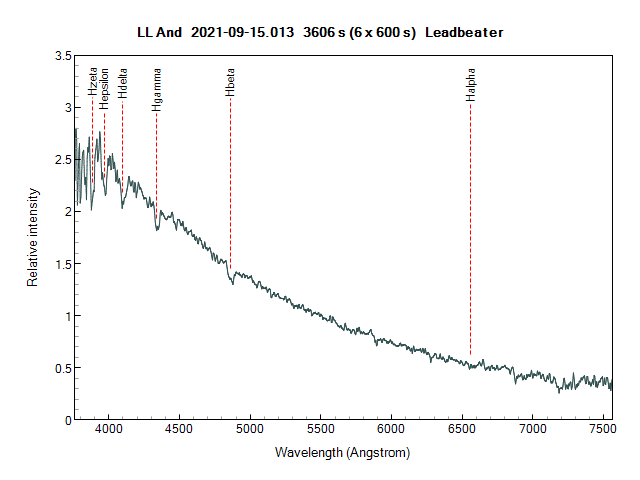
Robin
15 September 2021 at 5:14 pm #584682 Robin LeadbeaterParticipant
Robin LeadbeaterParticipantHi Gary,
Could “Nova And 1979” actually have been LL And with a position error? See VSSC #83 1995 p7 and separate thread on “N And 1979”
https://britastro.org/vss/VS0083.pdf
(Your first VSSC after you took over directorship in 1995 by the looks)
Robin
16 September 2021 at 4:27 pm #584684 Gary PoynerParticipant
Gary PoynerParticipantHi Robin,
I think it probably was LL And. I have a pre-print of a paper written by Taichi Kato in 1993 and printed in PASJ, which suggests that the 1979 Nova was indeed LL And (there were positional issues with the 1979 report). In it Kato-san writes (about the 1979 event)…
This supposed identification, which was later confirmed by the detection of a new outburst in 1993, of a relatively bright (19 mag) quiescent counterpart naturally suggested the dwarf nova-type classification. This information was quickly relayed to observers through the international alert networks (e.g. VSNET) and the object has been continuously monitored since then. The long-awaited next outburst finally occurred in 1993
I know I was observing it for a long time before the 1993 outburst, and was thrilled to see it for the first time then, confirming Tonny VanMunsters original detection. Indeed Tonny (in Belgium) and I were discussing the outburst on the telephone whilst looking at it through our telescopes! We did this several times in the 1990’s during rare outburst detections. Sadly those days are now gone – as has some of the fun of it.
Gary
19 September 2021 at 2:39 pm #584694 Robin LeadbeaterParticipant
Robin LeadbeaterParticipantThanks Gary.
The Taichi Kato paper was not published until 2004.
https://ui.adsabs.harvard.edu/abs/2004PASJ…56S.135K/abstract
I will send a correction to CDS
Cheers
Robin
21 September 2021 at 4:05 pm #584719 Robin LeadbeaterParticipant
Robin LeadbeaterParticipantAnother low resolution R~500 spectrum last night (low SNR due to bright full moon) continues to show no evidence of H alpha (in emission or absorption) but the higher Balmer absorption lines have increase in depth. V mag for the two spectra were ~12.8/13.7 (AAVSO)
Robin
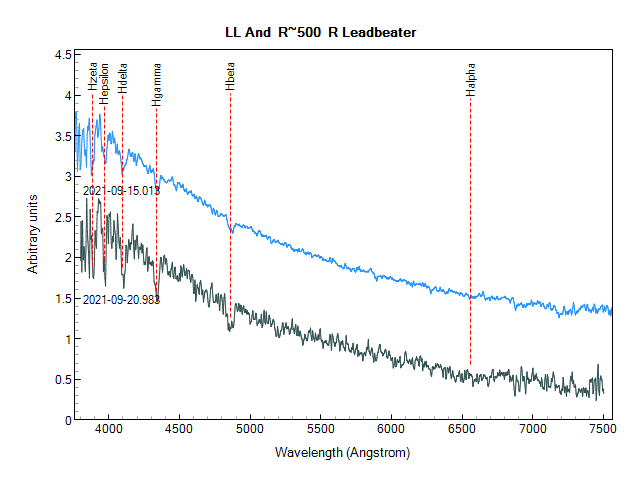 24 September 2021 at 4:38 pm #584727
24 September 2021 at 4:38 pm #584727 Jeremy ShearsParticipant
Jeremy ShearsParticipantLL And is currently around 14th mag and still in the plateau phase of its superoutburst. It is showing small, but elegant, superhumps. Further observations, including t/series photometry welcome.
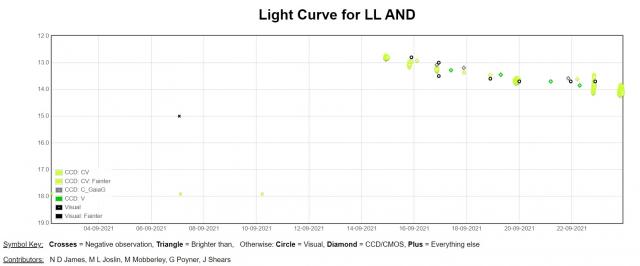 10 October 2021 at 6:26 pm #584767
10 October 2021 at 6:26 pm #584767 Jeremy ShearsParticipant
Jeremy ShearsParticipantLL And has been in outburst for nearly a month, but it is now fading (Gary Poyner had at mag 16.7 last night, Oct 9.965).
However, some rarely outbursting dwarf novae sometimes exhibit rebrightenings (sometimes referred to as echo outbursts). These can occur a few days after the outburst is apparently over. And there can be more than one rebrightening.
Therefore please continue to observe this star. Nightly snapshot observations over the next week or two would be helpful.
10 October 2021 at 10:57 pm #584768 Nick JamesParticipant
Nick JamesParticipantIt is certainly dropping quickly. I get 17.32 unfiltered tonight (2021-10-10 21:47:18).
11 October 2021 at 7:58 pm #584769 Grant PrivettParticipant
Grant PrivettParticipantCertainly looked a lot fainter from here…..
12 October 2021 at 11:36 am #584770 Gary PoynerParticipant
Gary PoynerParticipantHere is my light curve of the outburst so far. Last night (Oct 11) it was fainter then 17.9CV. LL And dropped just over two magnitudes in two days.
I’ll certainly continue to monitor for any rebrightening(s).
Gary
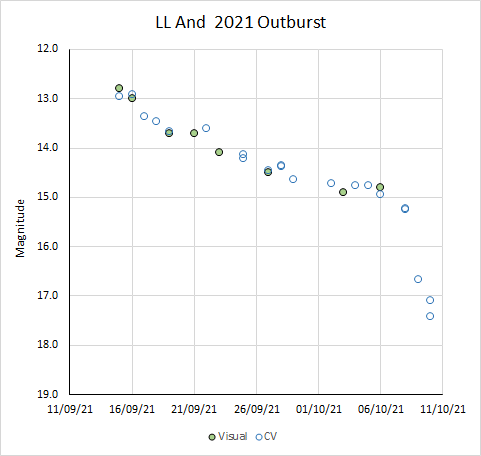 15 October 2021 at 6:35 pm #584776
15 October 2021 at 6:35 pm #584776 Grant PrivettParticipant
Grant PrivettParticipantWhile between OTAs, I have been using my 114mm guidescope and an unfiltered Lodestar to occasionally take some measurements of LL And. Because they were mainly taken on moonlit or partially cloudy nights (and I am a deep sky observer) I just let the camera run a series of 30s frames in the hope it might drive down the errors that would be present with such a small light grasp instrument. Its not the best way to do this sort of thing, but it was simple to do and fun.
To analyse the data, I wrote Python code to plate solve all the frames, locate all the stars, compare the catalogue stars to those on my frames, established the Zp for each frame and thus derive the mag of LL And. I then took the median result (mag1).
To make things more interesting, I also looked at 4 comparison stars from the AAVSO chart and derived mags (mag2) for those using the sums of the fluxes measured from all the frames. I may extend the number of comparison stars.
The results are these:
Date Mag1 Mag2 Magerr Frames
210917 13.15 13.32 0.15 122
210918 13.39 13.60 0.4 212
210921 13.71 13.90 0.25 307
210922 13.77 13.98 0.25 277
210929 14.58 14.71 0.35 156
211010 17.41 17.26 0.8 179
Usable results could have been obtained with far fewer frames, but I had hoped to see some evidence of superhump activity (yeah I know) so I just let it run.
What I am noticing from this – apart from how interesting LL And is – is that the Mag1 value seems consistently brighter than the Mag2 value. I won’t be submitting any observations formally until I figure out what causes that. Has anyone any thoughts on what I might be doing wrong?
EDIT: Andy worked out the problem and I am ashamed that I didn’t myself. One approach used the Gaia g catalogue mag values and the other used the AAVSO sequence mags ie V.
23 October 2021 at 9:54 am #584829 Jeremy ShearsParticipant
Jeremy ShearsParticipantHere is the light curve of the superoutburst until today (observations from the VSS database). No rebrightenings have been seen.
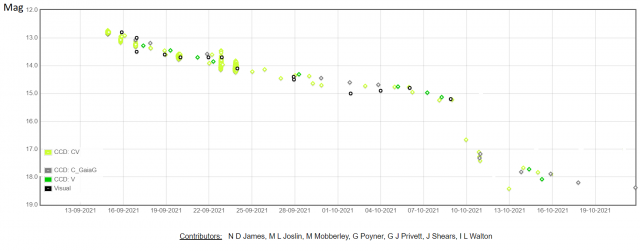
-
AuthorPosts
- You must be logged in to reply to this topic.
